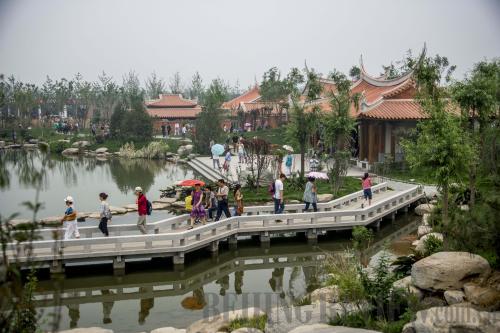|
 |
|
A PLACE FOR FUN: Visitors cross a footbridge in the Fujian Garden on June 2 (WANG XIANG) |
Please click here for more photos
A sprawling megapark complex featuring myriad gardening exhibits, artificial wetlands, advanced landscaping and diverse architectural works is set to breathe new life into a forgotten corner of the Chinese capital.
Hosted by China's Ministry of Housing and Urban-Rural Development and Beijing Municipal Government, the Ninth China (Beijing) International Garden Exposition covers a total area of 513 hectares and consists of 128 themed gardens as well as many integrated architectural and landscaping elements.
The coastal city of Dalian in Liaoning Province hosted the inaugural event in 1997. This year's expo began on May 18.
The fittingly named Beijing Garden Expo Park was built specifically for the event and chosen for its location along the Yongding River on the undeveloped southwestern outskirts of the capital.
The park has already received 500,000 visitors as of June 3. Qiang Jian, expo organizer and Deputy Director of the Beijing Municipal Bureau of Landscape and Forestry, expects that number to grow to 10 million before the expo concludes on November 18.
Rebirth of barren land
Fengtai District, a relatively undeveloped area outside the urban core, was chosen as the site for the Garden Expo Park due to a strategic urban development plan set forth by the Beijing Municipal Government in 2009, says Ji Yan, the district mayor.
He says Beijing is an international city, but its development is not balanced. The southern region of Beijing has lagged behind the rest of the capital for a long time.
The capital has been taking measures to develop its southern region since 2010, which has transformed the area from being heavily reliant on low-end industries such as cement factories and coal mines, into a bustling commercial center and home to innovative technology companies.
The establishment of the expo is part of these efforts. The Beijing Garden Expo might become a new mode of investment in the capital.
In 2010, the southern region of Beijing received a huge investment of 290 billion yuan ($47.3 billion) as part of a three-year urban development project. The garden expo is regarded as the centerpiece of the development plan, says Ji.
Previously, the local government did not place environmental protection high on its agenda of urbanization and industrialization. Ji believes the time is right to rectify unsustainable development patterns.
In 1997, authorities classified the Yongding River as unsuitable for use as a drinking water source. Excessive use of fertilizers and industrial waste rendered it barely useful for irrigation purposes, although factory closures and agricultural management improved water quality slightly in the 2000s.
Moreover, a 140-hectare landfill on the west bank of the river rendered the area unattractive as a residential neighborhood.
The three-year development plan transformed the area formerly occupied by the landfill with a picturesque Splendid Valley. Landscapers sealed the area to prevent seepage of waste materials and planted vegetation.
Ji emphasized the importance of new opportunities to boost continued development of southwestern Beijing.
Even transportation to the expo park has been improved. A new subway line connected the park and the Yongding River area to the city's main subway loop on May 5, and 24.2 km of new roads have been built, according to Gu Xiaoyuan, publicity director of the expo.
Yue Shulan, 43, a former resident of Changxindian Town, witnessed the transformation of her dilapidated village into a massive expo park complex.
"The road near my home was narrow and bumpy. In only a year, it has been turned into an eight-lane highway," Yue said excitedly. She and fellow villagers were relocated to new homes during the construction process.
Wang Fenghua, the spokesperson of Changxindian Town, said, "Over the past three years, all 5,300 villagers have moved to new apartments allocated by the local government as part of compensation for land acquisition by the expo."
Integrating the construction of the expo with renovation of undeveloped areas represents a great stride in improving the livelihood of local people.
Besides, the garden expo is built to be a permanent themed park, which will become a new pillar for local tourism and create more job opportunities for local residents.
Yue now works as a park custodian and earns a monthly salary of 2,000 yuan ($326). She expressed satisfaction with her new job. "I once worked downtown as a nanny and maid. Though I earned more before, I had to spend almost two hours on the commute from my home to downtown at that time. Now my workplace in the garden expo is a very convenient 10-minute walk from home."
Like Yue, more than 100 people in her village have been employed by the expo as security staff and gardeners.
In addition to offering job opportunities, the local government helps relocated residents to earn revenue from the land they gave up as shareholders of commercial developments.
A garden of gardens
As a country with many people and little arable land, China's gardens traditionally incorporate aspects of architecture and landscaping in a holistic manner, representing the wisdom of living in harmony with the environment and the dialectic balance between artifice and wilderness.
Five main gardens correspond to five representative cultural regions of China: Beijing, Chongqing, Fujian, Jiangsu and Guangdong.
| 